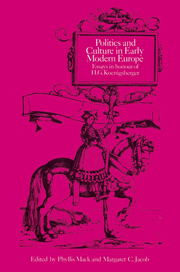Book contents
- Frontmatter
- Contents
- Introduction
- The court of the Spanish Habsburgs: a peculiar institution?
- The magnificent Lorenzo de' Medici: between myth and history
- Political rhetoric and poetic meaning in Renaissance culture: Clément Marot and the Field of Cloth of Gold
- The unlikely Machiavellian: William of Orange and the princely virtues
- The Estates of Brabant to the end of the fifteenth century: the make-up of the assembly
- Presents and pensions: a methodological search and the case study of Count Nils Bielke's prosecution for treason in connection with gratifications from France
- Between Bruni and Machiavelli: history, law and historicism in Poggio Bracciolini
- Constitutional discourse in France, 1527–1549
- Lieuwe van Aitzema: a soured but knowing eye
- John Calvin's contribution to representative government
- Luther and the humanists
- Scholars and ecclesiastical history in the Early Modern period: the influence of Ferdinando Ughelli
- ‘By an Orphean charm’: science and the two cultures in seventeenth-century England
- The crisis of the European mind: Hazard revisited
- Isaac Beeckman and music
- Decadence, shift, cultural changes and the universality of Leonardo da Vinci
- Bibliography of the writings of HELMUT GEORG KOENIGSBERGER
- Index
The Estates of Brabant to the end of the fifteenth century: the make-up of the assembly
Published online by Cambridge University Press: 20 October 2009
- Frontmatter
- Contents
- Introduction
- The court of the Spanish Habsburgs: a peculiar institution?
- The magnificent Lorenzo de' Medici: between myth and history
- Political rhetoric and poetic meaning in Renaissance culture: Clément Marot and the Field of Cloth of Gold
- The unlikely Machiavellian: William of Orange and the princely virtues
- The Estates of Brabant to the end of the fifteenth century: the make-up of the assembly
- Presents and pensions: a methodological search and the case study of Count Nils Bielke's prosecution for treason in connection with gratifications from France
- Between Bruni and Machiavelli: history, law and historicism in Poggio Bracciolini
- Constitutional discourse in France, 1527–1549
- Lieuwe van Aitzema: a soured but knowing eye
- John Calvin's contribution to representative government
- Luther and the humanists
- Scholars and ecclesiastical history in the Early Modern period: the influence of Ferdinando Ughelli
- ‘By an Orphean charm’: science and the two cultures in seventeenth-century England
- The crisis of the European mind: Hazard revisited
- Isaac Beeckman and music
- Decadence, shift, cultural changes and the universality of Leonardo da Vinci
- Bibliography of the writings of HELMUT GEORG KOENIGSBERGER
- Index
Summary
Since their inception, under the reign of the Duchess Jeanne (1356–1406, the last of the House of Louvain) and the ‘Joyous Entrance” of Philip the Fair (1494–1506, the elder son of the Emperor Maximilian and father of Charles V), the Assemblies of the Estates of the Country and Duchy of Brabant (die Staeten van Brabant), which were modeled after the French, exercized their mandate through the princes, first of a junior branch, then later the elder branch of the House of Burgundy–Valois, e.g., Antoine of Burgundy (1406–15), Jean IV (1415–27), Philippe de Saint-Pol (1427–30), Philip the Good (1430–67), Charles the Bold (1427–77), Marie of Burgundy (1477–82) and Maximilian of Austria (first as husband of Marie, then as tutor and Regent until the majority of Philip the Fair). The protocols, derived from the practices of the preceding century and a half, were observed without major alteration up until the demise of the Ancien Régime.
From beginning to end, the Assemblies of Brabant were made up of representative from three groups: the Prelates (die prelaeteri), the Barons and the Knights (die baenrodsen ende ridderen), and the cities and the townships (die steden ende vriheden). They were frequently convened by summons of the Prince – such was the practice – or else gave advice under their own initiative in exceptional circumstances. However, few who were summoned responded to the call; there were many more members called than representatives deputized to appear.
- Type
- Chapter
- Information
- Politics and Culture in Early Modern EuropeEssays in Honour of H. G. Koenigsberger, pp. 95 - 100Publisher: Cambridge University PressPrint publication year: 1987



